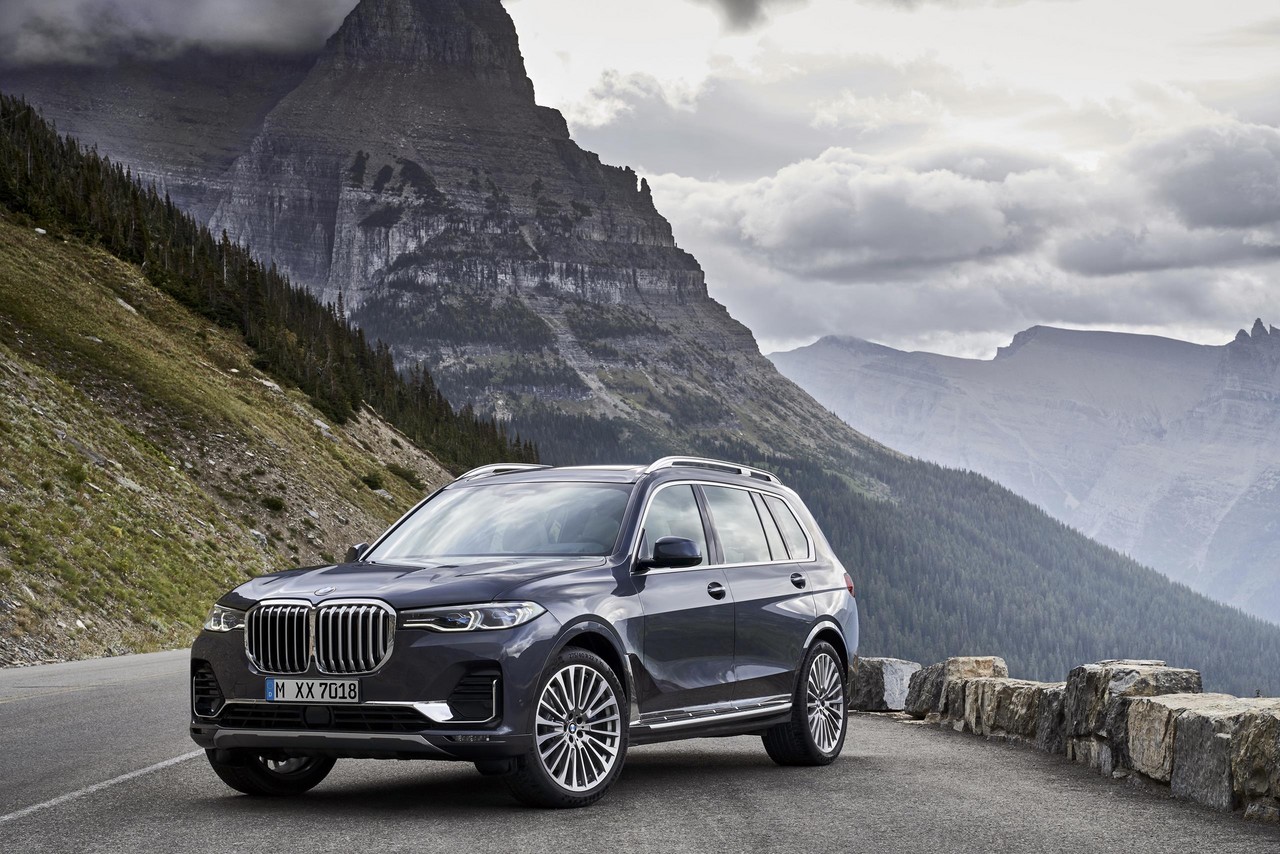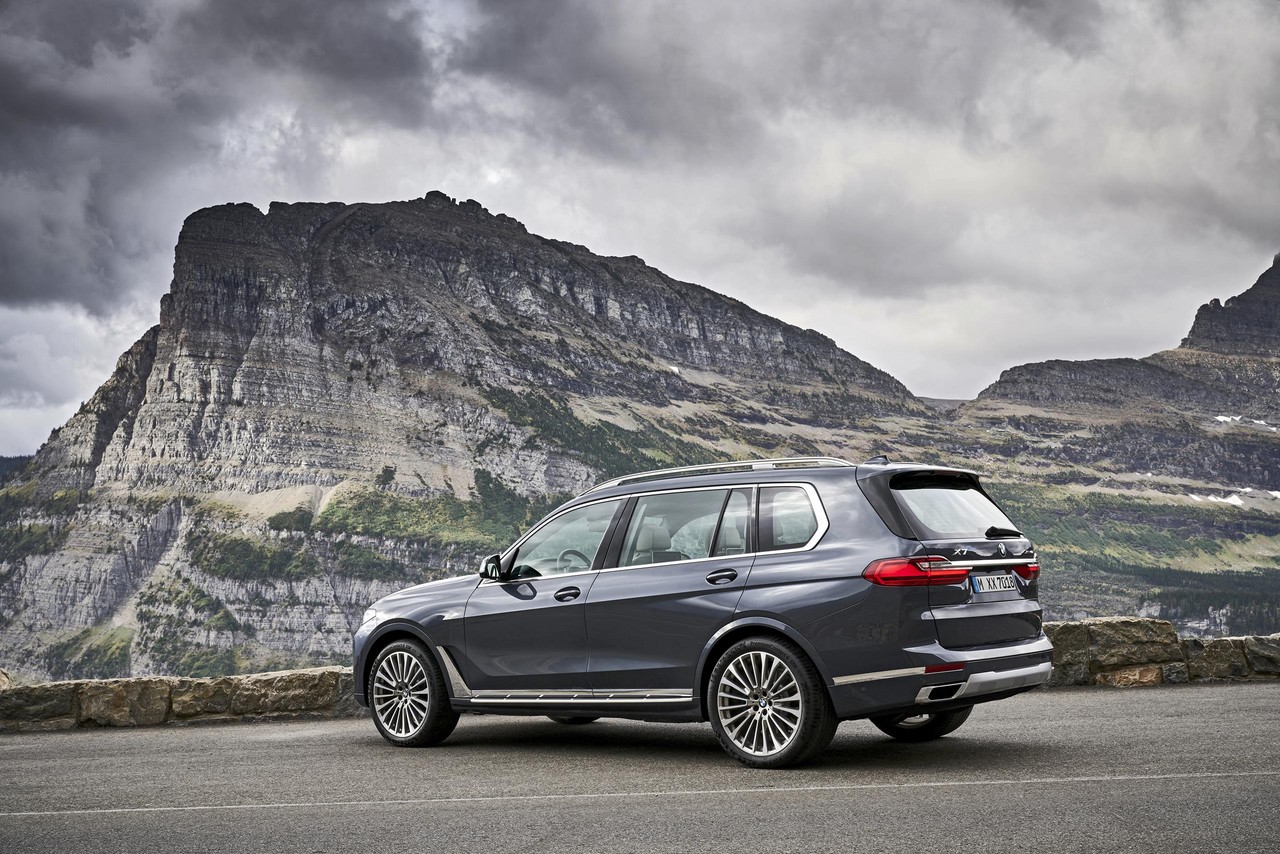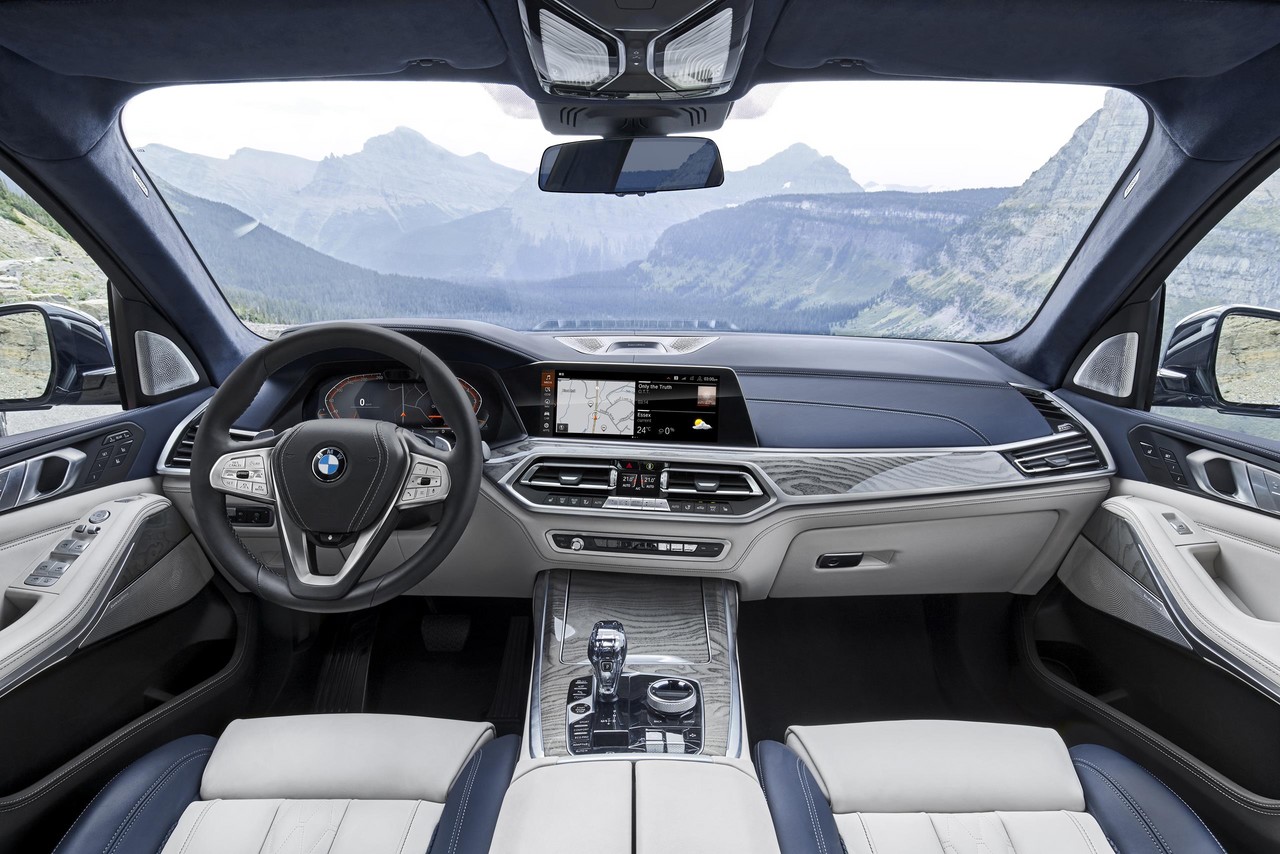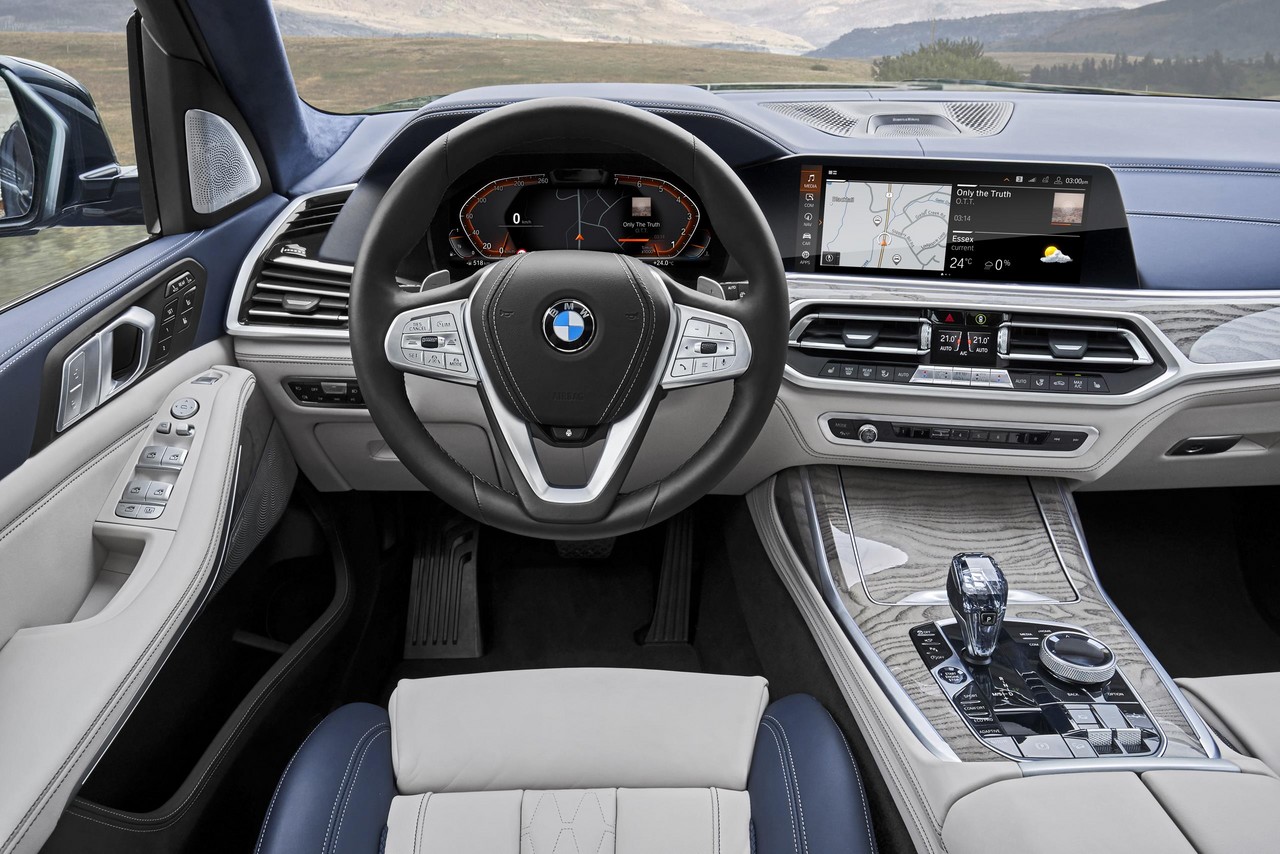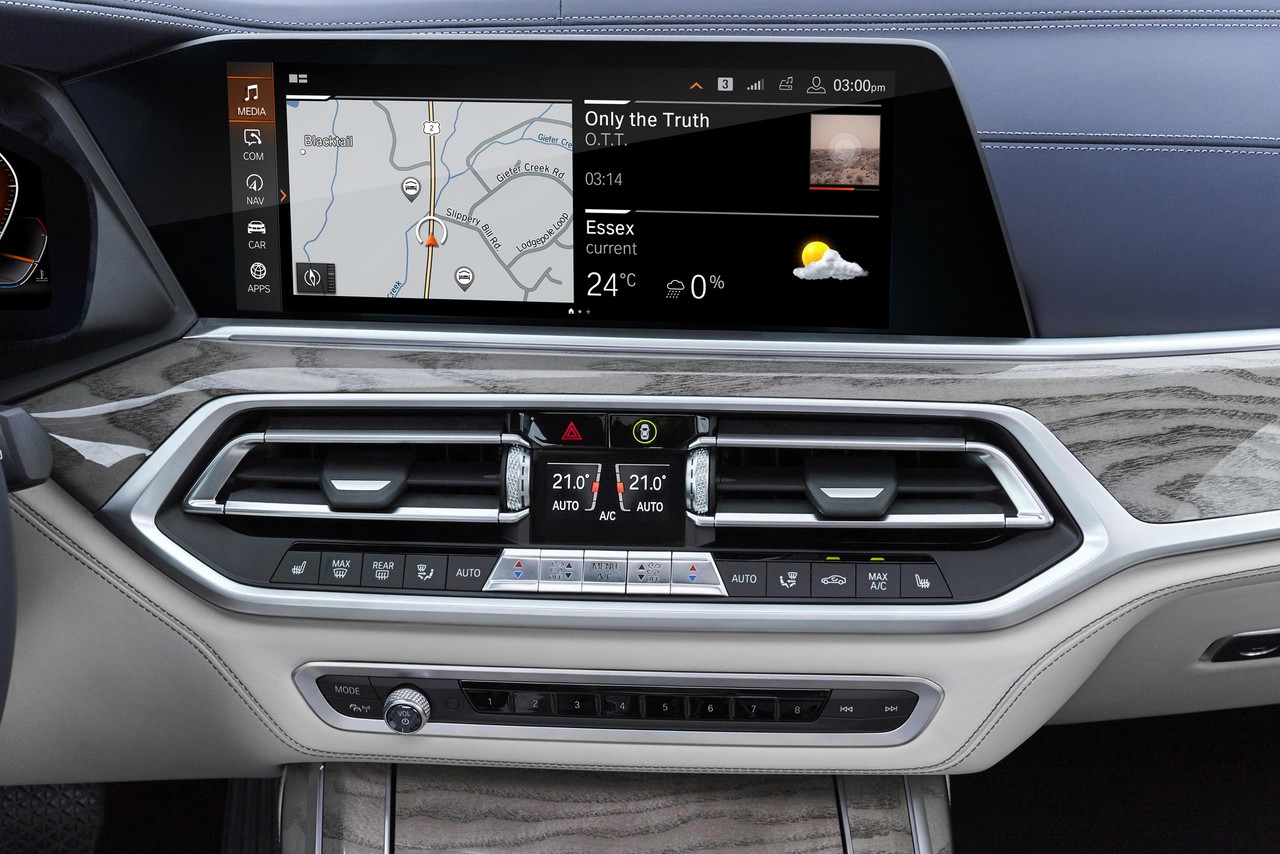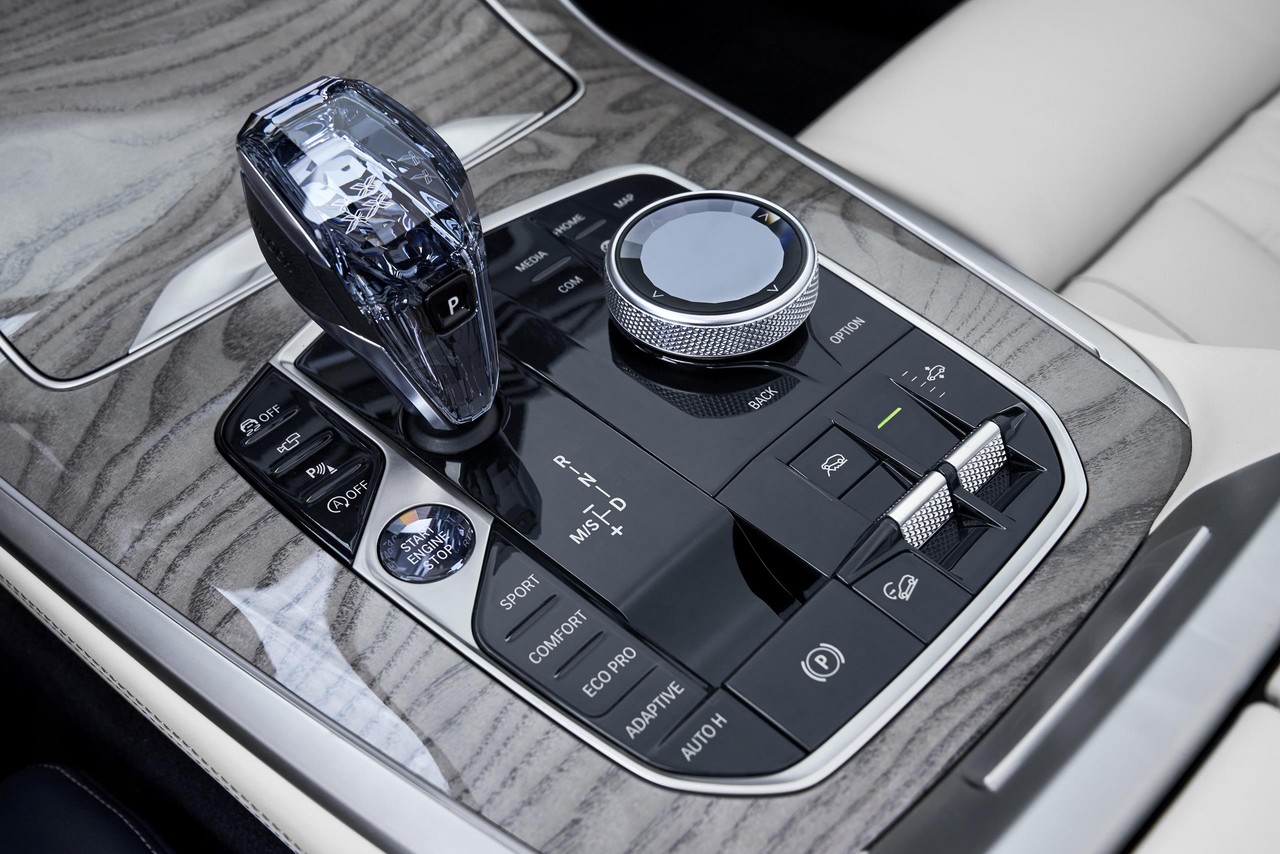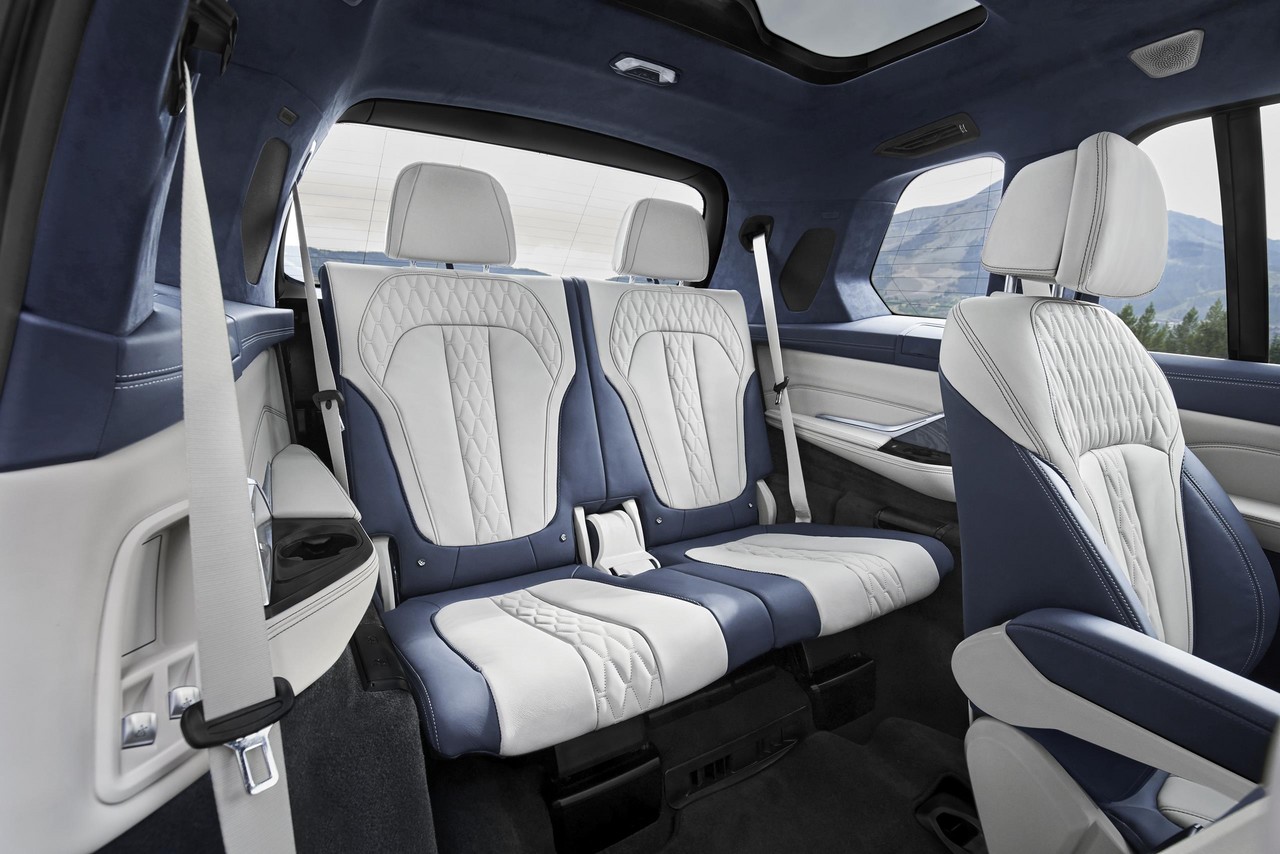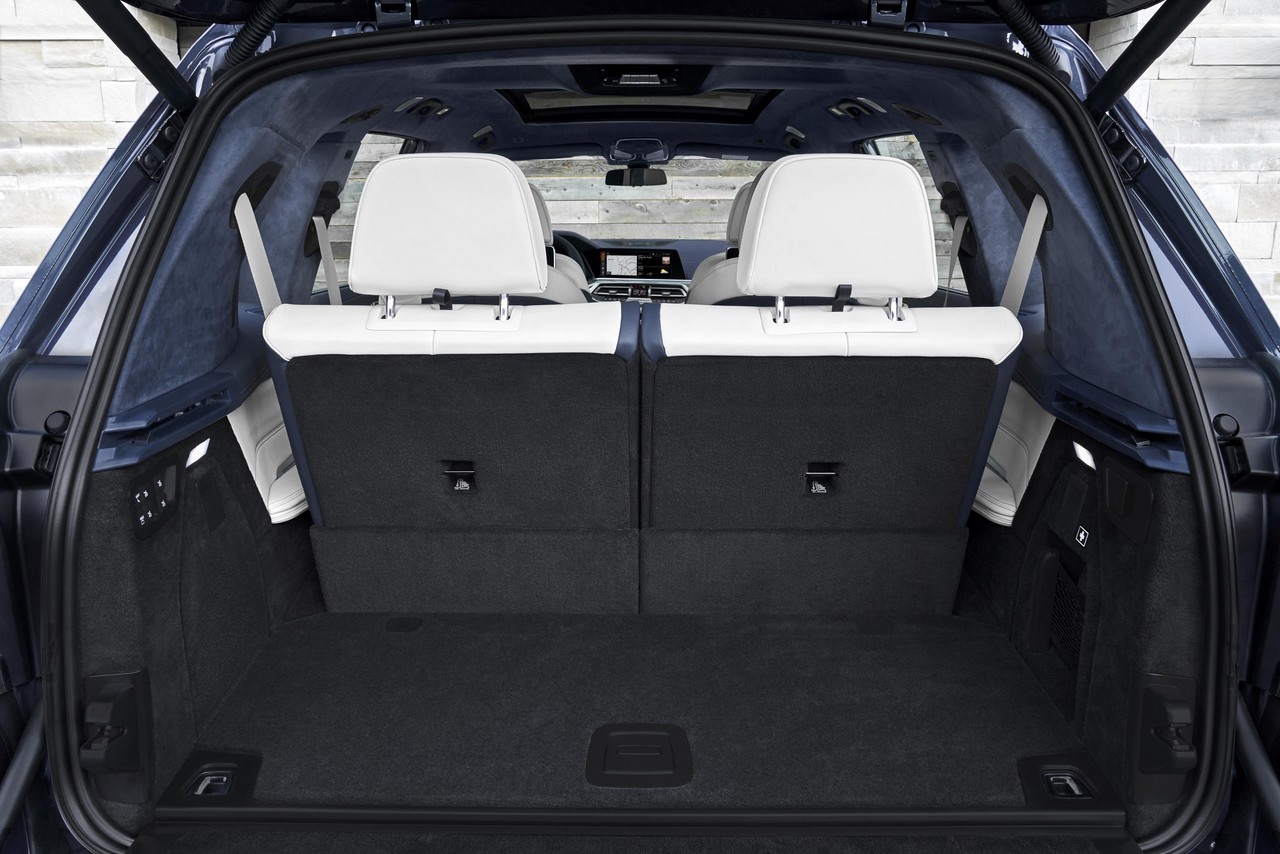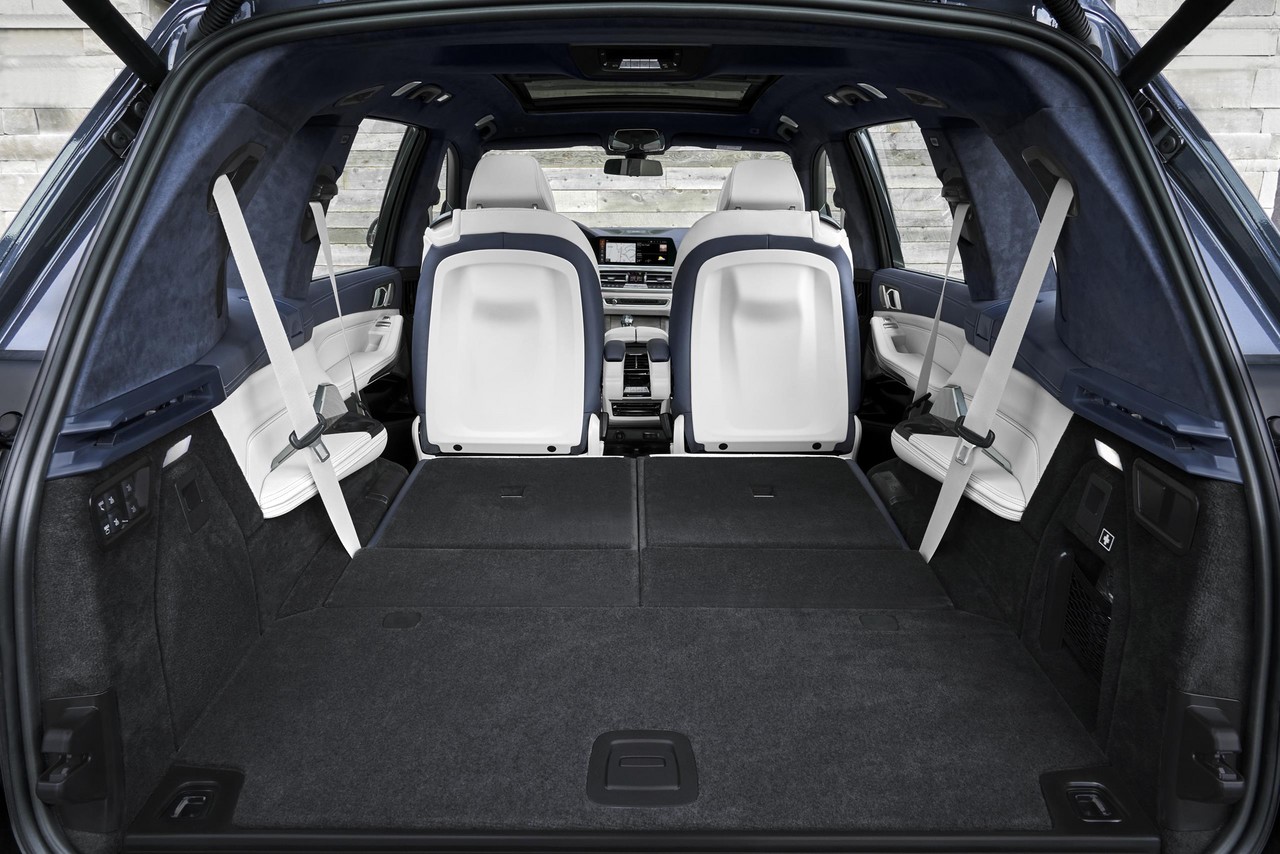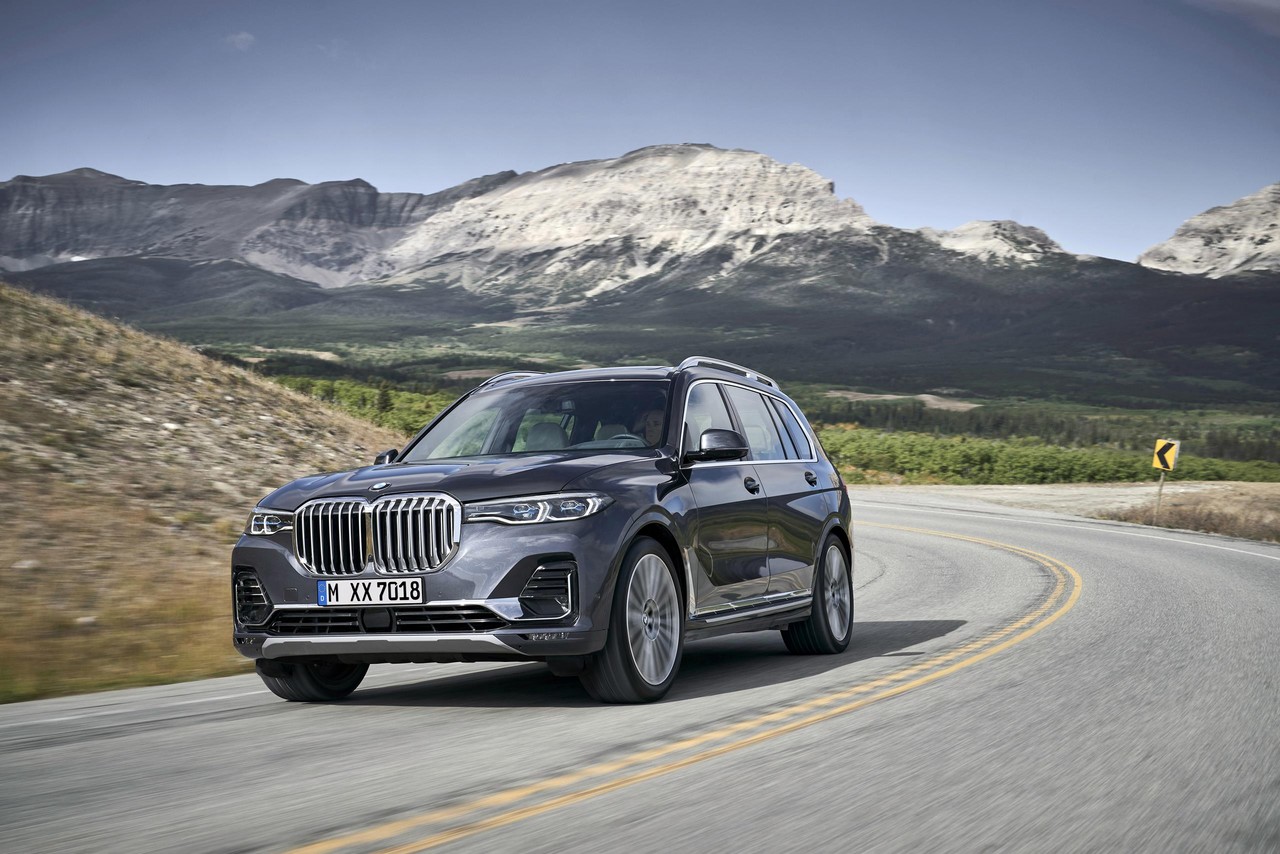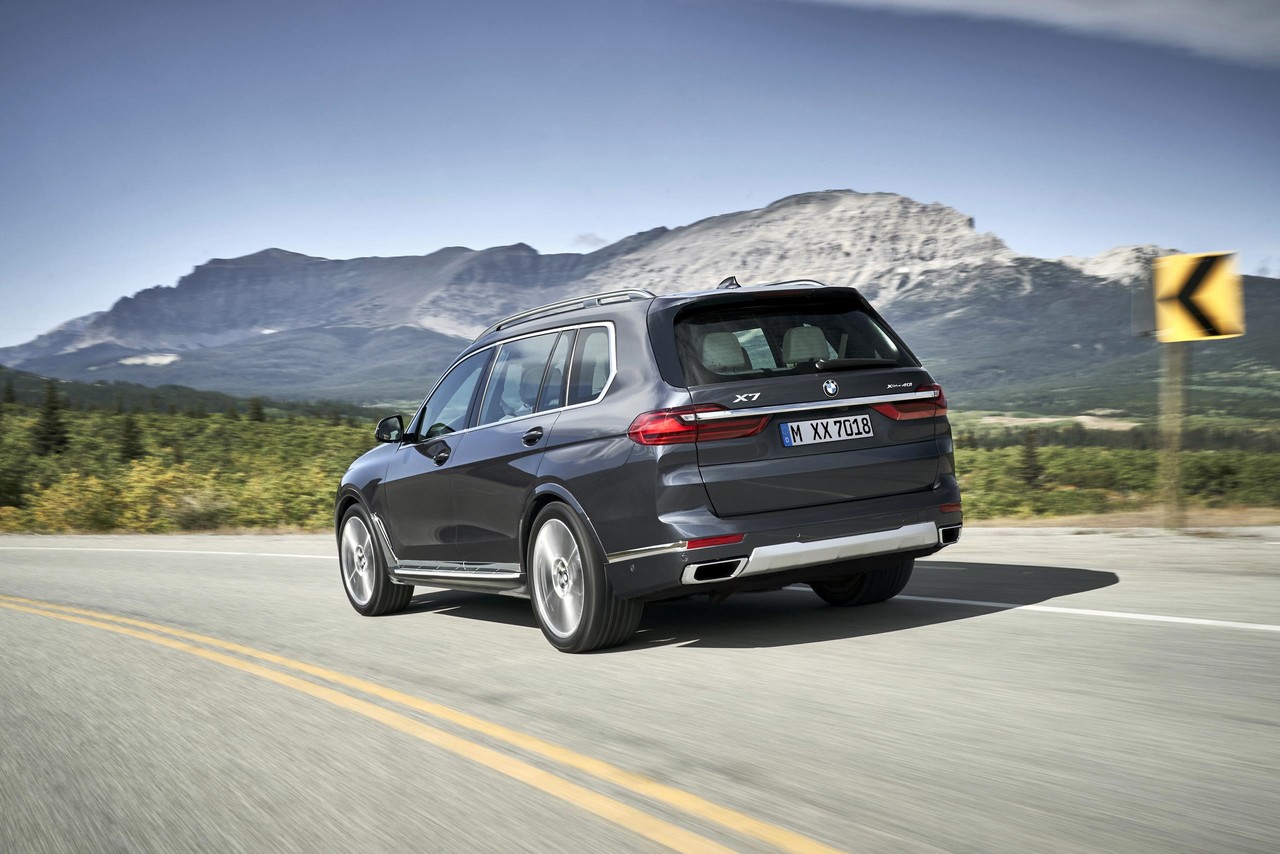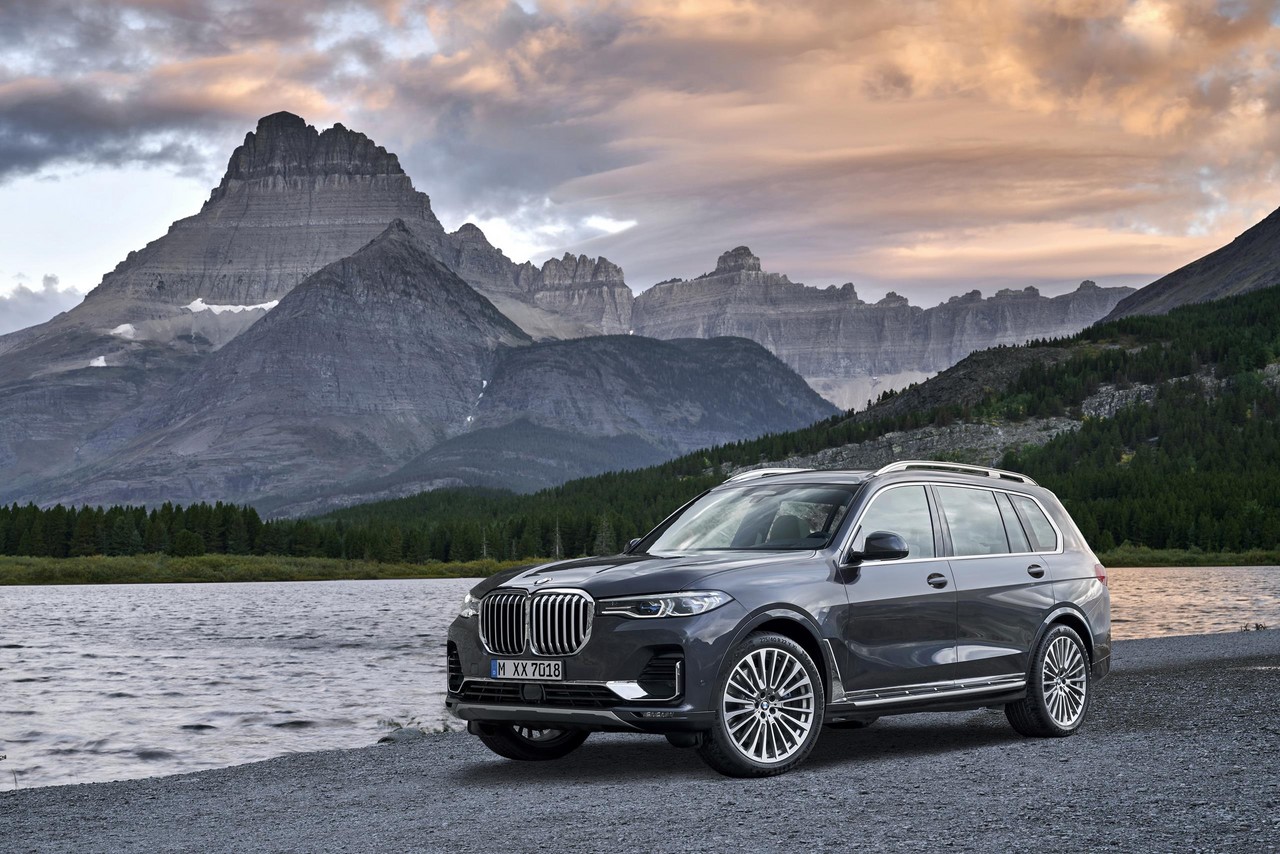
- Responsive turbocharged engines
- Anticipated dynamics
- Spacious and practical interior
- Steering feel?
- Suspension compliance?
- Occupant space for third row seats?
Overview
The BMW G07 X7 is a large, seven-seat ‘Sports Activity Vehicle’ (SAV) that will be released in Australia in May 2019. Manufactured at BMW’s Spartanburg plant in South Carolina, the all-wheel drive BMW G07 X7 range for Australia will initially consist of xDrive30d and M50d variants (see table below).
To reduce fuel consumption, all BMW X7 variants have:
- An ‘Auto Start Stop’ function which can shut down the engine when the vehicle is stationary in traffic;
- An ‘Eco Pro’ mode which adjusts engine management, throttle response and transmission behaviour to minimise fuel consumption. Eco Pro also includes a coasting function that can disengage the engine from the powertrain when the driver eases off the accelerator (to prevent engine braking); and,
- ‘Brake Energy Regeneration’ which regulates alternator output to recharge the battery when the vehicle is coasting or braking.
To reduce emissions, the xDrive40i and xDrive50i have a particulate filter, while the xDrive30d and M50d have a particulate filter, oxidation catalyst, NOx adsorption catalyst and selective catalytic reduction (SCR) which uses AdBlue injection.
Unusually, the 3.0-litre diesel engine for the BMW X7 M50d has two low-pressure turbochargers and two high-pressure turbochargers (the latter with variable inlet geometry). In normal driving situations, both low-pressure turbochargers and one of the two high-pressure turbochargers are active. The second high-pressure turbocharger, however, only engages once engine speed exceeds 2500 rpm. Under hard acceleration from idle, however, flaps are actuated so that the two low-pressure turbochargers are bypassed.
| Engine | Trans. | Peak power | Peak torque | |
|---|---|---|---|---|
| xDrive30d | 2993 cc B57D30O0 turbo diesel I4 | 8sp auto (ZF 8HP75) |
195 kW at 4000 rpm | 620 Nm at 2000-2500 rpm |
| M50d | 2993 cc B57D30 quad turbo diesel I6 | 8sp auto (ZF 8HP75) |
294 kW at 4400 rpm | 760 Nm at 2000-3000 rpm |
xDrive all-wheel drive system
AustralianCar.Reviews understands that the all-wheel drive system for the BMW G07 X7 has an electronically controlled, multi-plate clutch in the transfer case. The ‘xDrive’ all-wheel drive system is able to vary drive torque between the front and rear wheels and, when all-wheel drive is not required, all the engine’s torque is directed solely to the rear wheels. Furthermore, the xDrive system maintains a rear-biased torque split ‘when the car’s dynamic performance abilities are being put to the test’.
Australian-delivered BMW X7 M50d vehicles are equipped with an ‘M Sport’ differential (i.e. an electronically controlled rear differential lock). Controlled by the electronic stability control system (BMW’s ‘DSC’), the locking function for the rear differential could prevent a wheel from spinning in low-traction situations, thereby improving traction and power transmission when driving on loose ground or surfaces with variable grip levels. This locking effect was achieved by an electric motor and allowed up to 1500 Nm of drive torque to be redirected from the faster-turning (i.e. low traction) wheel to the slower-turning wheel.
For the optional Off-Road package, the driver can select from xSnow, xSand, xGravel and xRocks drive modes – via a button on the centre console – which adjust ride height, torque distribution for xDrive, accelerator response, transmission control and the DSC system. The Off-Road package also includes protective underbody elements and, inside, special graphics in the instrument cluster and Control Display.
Dimensions and body
Compared to the BMW G05 X5 , the G07 X7 is 229 mm longer (at 5151 mm), 4 mm narrower (2000 mm), 60 mm taller (1805 mm) and has a 130 mm longer wheelbase (3105 mm); ground clearance is 221 mm and the X7 has a fording depth of 500 mm (at 7 km/h). Furthermore, the BMW G07 X7 has a drag co-efficient of 0.33 Cd (for the xDrive40i and xDrive30d).
Inside, all three rows of seats for the MW X7 have power adjustment for fore/aft movement. Beyond this,
- The second row seats – which have a 40/20/40 split but can also split 60/40 – can slide longitudinally over 145 mm; and,
- The backrests of the second and third row seats can be folded down and back up electrically – the buttons for this functionality are located on the passenger’s side when entering through the rear doors and in the boot.
Luggage capacity for the BMW X7 is 326 litres when all seats are in use, though this increases to 2120 litres when the second and third row seats are folded down. Finally, the BMW X7 has a power-operated, hands-free split tailgate that can be opened by foot movement beneath the rear bumper.
While the BMW X7 has seven seats as standard, it can be specified as a six-seater in which the second row of seats consists of two separate ‘comfort’ seats that have the same range of adjustment as the front seats, integrated armrests and ‘comfort cushions’.
Suspension
The BMW G07 X7 has aluminium double wishbone front suspension and a steel five-link rear axle. As standard, the BMW X7 has air suspension front and rear in which the suspension’s air supply is controlled individually for each wheel by an electrically driven compressor with pressure reservoir. Since the air suspension is integrated with the Dynamic Stability Control (DSC) system, loads registered by the air suspension sensors can be factored into braking modulation. For the air suspension system,
- When the ‘Sport’ drive mode is engaged or vehicle speed exceeds 138 km/h, ride height is automatically lowered by 20 mm;
- The driver is able to raise ride height by up to 40 mm above the standard setting (in two stages) for off-road driving; and,
- The driver is able to lower ride height by 40 mm – for loading or unloading the vehicle – by pressing a button in the luggage compartment.
The rear axle also has an automatic self-levelling function.
Australian-delivered BMW X7 M50d vehicles are fitted with BMW’s ‘Executive Drive Pro’ active roll stabilisation. For Executive Drive Pro, the anti-roll bars at the front and rear axles are split and each one is connected in the centre by an electric swivel motor. Actuation of the swivel motor causes the two links on the anti-roll bar to twist and counteract the forces which create roll.
Steering
The BMW G07 X7 has rack-and-pinion steering with electric power assistance; the G07 X7’s turning circle is 13.0 metres, while the overall steering ratio is 18.7:1.
Australian-delivered BMW X7 M50d vehicles are fitted with BMW’s ‘Integral Active Steering’ provides rear wheel steering. At parking speeds, the rear wheels turn in the opposite direction to the front wheels to reduce the turning radius. At higher speeds, however, the rear wheels turn in the same direction as the front wheels for greater stability.
Safety equipment
Standard safety equipment for the BMW G07 X7 includes dual front airbags, front seat-mounted side airbags, full-length curtain airbags (i.e. for front and second row seats), ABS, electronic brake force distribution, electronic stability control, traction control and front seatbelts with pre-tensioners and load limiters.
Australian-delivered BMW G07 X7 vehicles are expected to be equipped with the following safety technologies as standard:
- Forward Collision Warning and Pedestrian Warning with City Braking: operating at speeds between 10 and 60 km/h, the system warns the driver if a pedestrian or stationary vehicle is detected in the BMW X7’s path. If the driver fails to react, the system automatically applies the brakes to prevent or minimise the severity of a collision;
- Active Cruise Control with Stop&Go function: at speeds from 30 km/h to 210 km/h, Active Cruise Control can maintain a speed-dependent distance from the vehicle ahead. With the Stop&Go function, the brakes can be applied to bring the G07 X7 to rest; once the traffic ahead begins to accelerate, the BMW X7 will automatically accelerate if the vehicle has been stationary for less than 30 seconds;
- Lane Keeping Assistant: helps the driver pre-empt hazards by automatically applying corrective steering in three situations: 1) if the system detects that the vehicle is about to leave the road, 2) if the driver is about to change lanes and has not seen a vehicle in the next lane or 3) if danger is detected due to an approaching vehicle (see ‘Side Collision Warning’, below). Furthermore, holding the direction indicator could initiate a lane change;
- Lane Departure Warning: active at speeds above 72 km/h, the driver is alerted by steering wheel vibrations if the vehicle deviates from its lane without prior activation of the indicators and active steering inputs bring the vehicle back to its intended lane;
- Lane Change Warning: active at speeds above 10 km/h, Lane Change Warning monitors the zones to each side of the vehicle. If the driver activates the indicators to change lanes, the system checks these zones and – if occupied – warns the driver via steering wheel vibrations and a flashing a symbol in the appropriate door mirror;
- Side Collision Warning: operating at speeds between 30 km/h and 210 km/h, Side Collision Warning alerts the driver via a visual signal or steering wheel vibration if another vehicle is ‘encroaching’ from the side. If the system detects sufficient room on the other side of the vehicle, it correctively steers the vehicle in this direction to avoid the danger. The corrective steering assistance, however, can be over-ridden by the driver at any time;
- Steering and lane control assistant: operating at speeds up to 210 km/h, the steering and lane control assistant provides ‘comfort-enhancing steering interventions’ to keep the vehicle in its current lane (even where road markings are unclear). In stop-start traffic, the system also uses the preceding vehicle as a reference point;
- Evasion aid: operating at speeds up to 160 km/h, the evasion aid helps avoid collisions with vehicles or pedestrians that suddenly appear in the driver’s path by providing steering inputs that assist the driver to direct the vehicle into a clear adjacent lane;
- Crossing traffic warning front: uses radar sensors to check for approaching traffic at junctions with poor or impeded visibility;
- Crossing-traffic warning rear: when reversing out of a parking space, ‘Crossing-traffic warning rear’ warns the driver of approaching traffic that may intersect the driver’s intended path;
- Crossroads warning: provides visual and audible warnings in priority situations (i.e. where vehicles on another road had right of way) and at stop signs. At speeds up to 84 km/h, the steering wheel also vibrates to alert the driver;
- Rear Collision warning: if a rear-end collision is anticipated, following traffic would be warned by double frequency flashing of the hazard lights;
- Active Protection: if a collision risk is detected, including from preceding vehicles or stationary objects, Active Protection activates the front seatbelt tensioners and closes the windows (and sunroof, where fitted). After a collision, Active Protection automatically applies the brakes to bring the vehicle to rest, thereby reducing the likelihood and potential severity of a secondary collision;
- Attentiveness Assistant: monitors driver behaviour for signs of fatigue and, if detected, provides visual and audible warnings; and,
- Speed Limit Info: incorporated speed restrictions into the driver-selectable Speed Limiter function or Active Cruise Control.
Features: BMW G07 X7 xDrive30d
The BMW G07 X7 is equipped with BMW’s ‘Live Cockpit Professional’ which consists of a 12.3-inch (1920 x 1080) high-resolution instrument cluster display, another 12.3-inch ‘Control Display’, a navigation system, a hard-drive based multimedia system with 20 GB of memory, a ‘HiFi’ audio system with ten speakers, a digital radio tuner (DAB+), two front USB ports (type A and type C), two rear USB ports (type C), Bluetooth mobile phone connectivity, voice control, Apple CarPlay smartphone integration, wireless mobile phone charging and WiFi interfaces. The BMW X7 also had a 12.3-inch display for its digital instrument cluster.
Beyond this, standard features for the BMW G07 X7 include 20-inch alloy wheels, ‘Vernsaca’ leather upholstery, power adjustable and heated front ‘sport’ seats, four-zone climate control air conditioning, cruise control with braking function, adaptive LED headlights, front LED fog lights, rear fog lights, dusk-sensing headlights, rain-sensing wipers, front and rear parking sensors (BMW’s ‘Park Distance Control’), a rear view camera, a head-up display, a leather-wrapped steering wheel, remote central locking with proximity key (BMW’s ‘Comfort Access’), power adjustable and heated mirrors with folding function, power windows, tilt/telescopic steering wheel adjustment, electrochromatic door mirrors and interior rear view mirror, a three-part panoramic glass sunroof with power operation, roof rails, a power-operated split tailgate with contactless operation, soft-close doors, an electric park brake, push-button start, ambient interior lighting, 12 volt power sockets, velour floor mats, tyre pressure monitoring and an immobiliser.
For Australian-delivered vehicles, the BMW G07 X7 is also equipped with –
- BMW’s ‘Parking Assistant’: uses ultrasonic sensors to detect parking spaces and controls acceleration, braking, steering and gear changes to manoeuvre the vehicle into the space;
- BMW’s ‘Parking Assistant Plus’ which includes a rear-view camera, Top View, Panorama and 3D View functions to create a 360-degree image of the vehicle and its surroundings in the Control Display. Furthermore, the Remote 3D View feature can be used to access a three-dimensional live image of their vehicle and surroundings on a smartphone; and,
- BMW’s ‘Reversing Assistant’: when exiting a parking space or manoeuvring in a confined area, the Reversing Assistant controls steering to reverse the vehicle along a path it has recently travelled forwards up to a distance of 50 metres. The Reversing Assistant is activated by pressing a button when the vehicle is stationary and the gear selector is in ‘Park’.
Features: BMW G07 X7 M50d
Compared to the BMW X7 xDrive30d, the BMW G07 X7 M50d is further equipped with 22-inch ‘M’ alloy wheels, a harman kardon surround sound system, ‘Comfort’ front seats with memory settings (driver and front passenger), cushions for the second row outer headrests, ‘Merino’ leather upholstery, five-zone climate control air conditioning, extended leather trim, fine-wood interior trim finishes and heated/cooled front cup holders.
Beyond this, the BMW X7 M50d is also equipped with:
- BMW ‘Laserlight’ with Adaptive LED Headlights and Selective Beam which provide non-dazzling high beam range of around 600 metres; and,
- An ‘M Sport’ package which includes an ‘M Sport’ leather steering wheel, ‘BMW Individual’ headliner in anthracite-coloured Alcantara, M-specific detailing (for the pedals, driver’s footrest and seat piping).
Visually, the BMW X7 M50d can be identified by its ‘M Aerodynamics’ package.
Options: BMW G07 X7
Optional features for the BMW G07 X7 are expected to include:
- Multi-function front seats with massage and ventilation functions;
- A Bowers & Wilkins Diamond Surround Sound System with twenty speakers and peak output of 1700 watts; and,
- An ‘Ambient Air’ package which provides air ionisation and infuses the interior with eight individually selectable scents;
- BMW’s ‘Sky Lounge’ panoramic glass roof which uses LEDs to illuminate more than 15,000 graphic patterns and ‘generate a display reminiscent of a starlit sky’;
- An ‘Ambient Air’ package which provided air ionisation and infused the interior with eight individually selectable scents; and,
- BMW ‘Professional’ rear-seat entertainment system which consisted of two 10.2-inch full-HD touchscreens, a Blu-ray compatible DVD player, two USB ports, an HDMI socket and two headphone jacks. Rear-seat passengers could use their own media sources or those available in the front compartment, while a navigation map and BMW ConnectedDrive services could also be accessed from the rear seats.
Specifications
Related links
